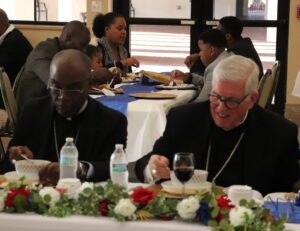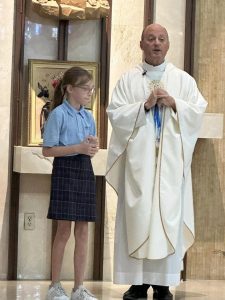Our Blessed Mother is recognized and celebrated in a special way on Dec. 8, 2025, the Solemnity of the Immaculate Conception of the Blessed Virgin Mary.
As Dec. 8 falls on a Monday, the Solemnity is a Holy Day of Obligation and the Patronal Feast Day of the United States. The Solemnity of the Immaculate Conception retains the precept to attend Mass when it falls on a Monday. Catholics are obligated to attend Mass on this day.

“Born without Original Sin, and chosen by God to bear His only Son, Mary plays an essential role in Christmas and in salvation,” Bishop Frank J. Dewane said. “Her Motherhood of Jesus Christ, Our Savior, made possible a pathway to Heaven for all the faithful. The Blessed Mother still intercedes on our behalf, drawing the faithful closer to Jesus and to God, through prayer.”
One of the most often confused Doctrines of the Catholic Church, many people, including Catholics, mistakenly think that the Immaculate Conception refers to the conception of Christ through the action of the Holy Spirit in the womb of the Blessed Virgin Mary. That event is in fact celebrated as the Feast of the Annunciation of the Lord on March 25, nine months before Christmas.
The Immaculate Conception, which is celebrated on Dec. 8, refers to the condition that the Blessed Virgin Mary was free from Original Sin from the very moment of her conception in the womb of her mother, St. Anne. The Church celebrates the Nativity of the Blessed Virgin Mary on Sept. 8, nine months after the Immaculate Conception.
The doctrine of the Immaculate Conception dates back centuries, declared as doctrine by Pope Pius IX on Dec. 8, 1854.
Pope Francis said in 2024 that on the Solemnity of the Immaculate Conception the “Church contemplates the one who is ‘full of grace’… This is how God saw her from the very beginning in His plan of love. He saw her as beautiful, full of grace… Mary the Immaculate is inscribed in God’s plan; she is the fruit of the love of God that saves the world.”
On the Solemnity this year, Pope Leo XIV will continue the papal tradition of visiting the statue of the Blessed Virgin Mary near Rome’s Spanish Steps.
INFO BOX
Holy Days of Obligation
According to Church doctrine, Holy Days of Obligation are feast days on which Catholics are required to attend Mass and to avoid (to the extent that they are able) servile work. Holy Days of Obligation during Advent and Christmas seasons include:
the Solemnity of Immaculate Conception (Dec. 8), Christmas (Dec. 25), and the Solemnity of Mary, the Holy Mother of God, (Jan. 1, 2026).






 The Bishop explained how St. Pope Gregory III established the modern-day All Saints Day early in the 8th century and stressed the need to begin the vigil for the solemnity the day before, thus creating All Hallows Eve.
The Bishop explained how St. Pope Gregory III established the modern-day All Saints Day early in the 8th century and stressed the need to begin the vigil for the solemnity the day before, thus creating All Hallows Eve.




 Father David Portorreal celebrated Mass for the students at Bishop Verot Catholic High School in Fort Myers. Part of his message was a gentle reminder that the Solemnity celebrates the Immaculate Conception of Mary in her mother, St. Anne. The Immaculate Conception does not refer to the original conception and birth of Christ, as is often thought, but rather to the conception of the Blessed Virgin Mary, who was conceived without inheriting original sin.
Father David Portorreal celebrated Mass for the students at Bishop Verot Catholic High School in Fort Myers. Part of his message was a gentle reminder that the Solemnity celebrates the Immaculate Conception of Mary in her mother, St. Anne. The Immaculate Conception does not refer to the original conception and birth of Christ, as is often thought, but rather to the conception of the Blessed Virgin Mary, who was conceived without inheriting original sin.